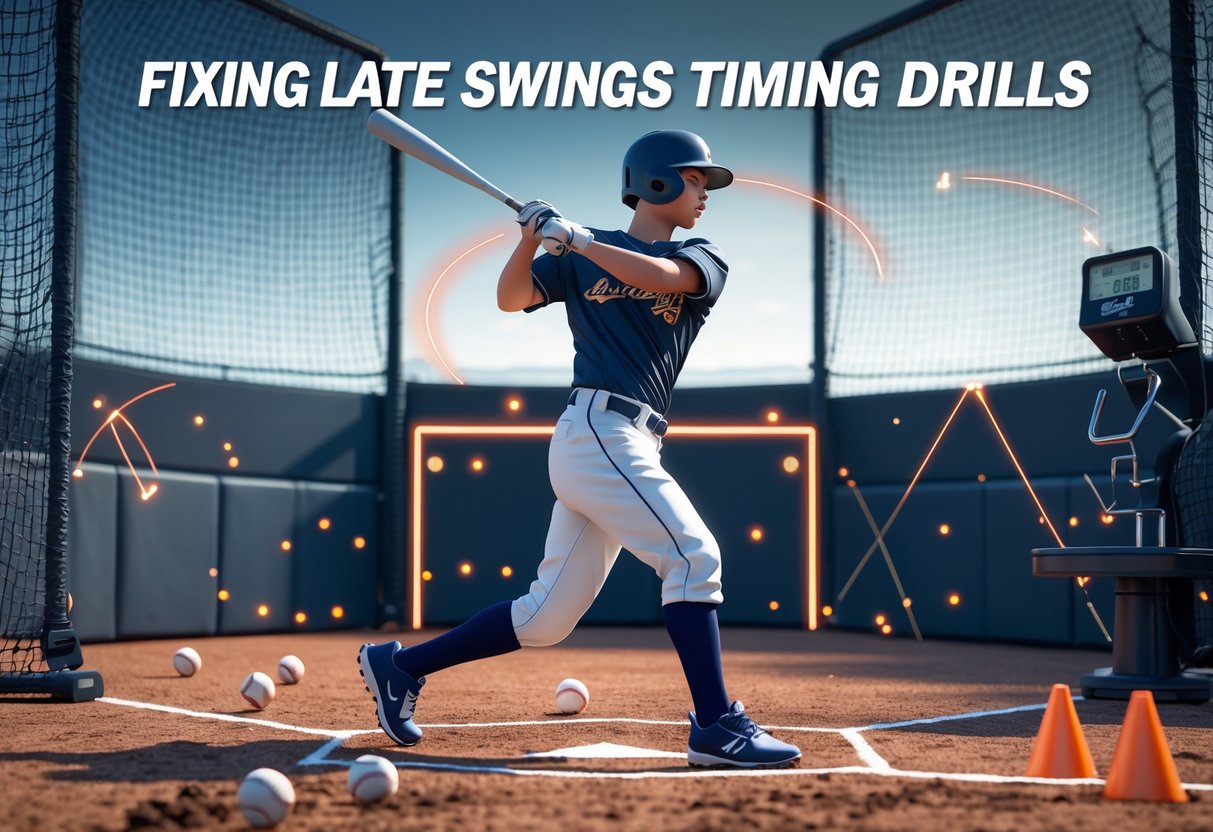Timing Drills: Essential Techniques to Boost Hitting Performance
Updated On: October 26, 2025 by Aaron Connolly
Introduction to Timing Drills
Timing drills help baseball players get better at coordination and reaction speed when hitting. These exercises fix common swing issues and build consistent hitting skills with regular practice.
Purpose of Timing Drills
We use timing drills to work on three things: hand-eye coordination, swing consistency, and pitch recognition.
These drills teach players when to start their swing based on how the pitcher delivers the ball.
Coordination Development
Timing drills connect what players see to how they react. The bat drop drill, for example, challenges reaction speed by forcing quick decisions.
Swing Mechanics
Practicing timing exercises over and over builds muscle memory. Players pick up proper hip rotation and hand positioning through repetition.
Game Preparation
These drills feel like real games. Front toss exercises let players adjust to different pitch speeds and locations.
Overview of Hitting Performance Gains
Players who stick with timing drills usually see real improvements in their hitting. We measure progress by how often they make contact and the quality of their swings.
Contact Rate Improvements
Most players increase their contact rate within about a month of steady timing drills. Better timing means fewer missed swings.
Power Development
When players sync their swing with the pitch, they hit harder. That’s just how it works—timing gives you max bat speed at contact.
Pitch Recognition
Timing drills help players read pitches faster. This skill helps them decide to swing or hold back.
| Performance Area | Typical Improvement | Time Frame |
|---|---|---|
| Contact Rate | 15-20% increase | 4-6 weeks |
| Swing Speed | 5-8 mph faster | 6-8 weeks |
| Strike Zone Recognition | 25% better | 3-4 weeks |
Common Timing Mistakes
Players at all levels struggle with timing because they fall into the same traps.
Starting Too Late
Late swings happen when players hesitate. They rush and make weak contact.
Overthinking Mechanics
Some players get stuck worrying about perfect form and forget about natural timing. That just slows down their reactions.
Inconsistent Practice
Timing needs daily work. If you only practice once or twice a week, you won’t build reliable habits.
Poor Stance Setup
Bad foot positioning throws off timing. Players need good balance to start their swing at the right time.
Understanding Swing Timing in Hitting
Proper swing timing depends on how your brain processes pitch info, how fast you react, and how well you spot different pitches. All three of these work together to decide if you make solid contact or swing late.
The Science Behind Swing Timing
Swing timing starts in your brain roughly 150 milliseconds before you swing. Your nervous system grabs visual cues from the pitcher’s release and tells you to swing or not.
Hitters get about 400-500 milliseconds from pitch release to contact. During that window, your brain figures out pitch type, location, and speed. It’s way faster than you can consciously think.
Your body uses something called “predictive timing,” not just reacting. You start your swing based on what you expect the pitch to do, not what you see in real time.
Elite hitters develop patterns so they can guess pitch behavior. The trick is keeping a steady rhythm in your swing prep.
If your timing feels weird, your pre-swing routine probably changed. Even small tweaks to your stance or stride can mess up your whole timing chain.
Role of Reaction Time
Reaction time in hitting isn’t just about being fast. You need to move efficiently and make smart choices under pressure.
Average reaction time for most people falls around 200-250 milliseconds. But in hitting, recognition time matters more than pure reaction.
You have to figure out what kind of pitch is coming and where it’s headed. Fast pitches give you less time, but they’re often easier to time since they follow predictable paths.
Slower pitches like changeups throw off your timing. They look quick but arrive late.
You can train reaction time by practicing with different pitch speeds and types. Soft toss drills can improve reaction time by up to 30% if you stick with them.
The big thing is building muscle memory so your body just reacts.
Impact of Pitch Recognition
Advanced pitch recognition sets great hitters apart. It’s all about seeing the pitch early and making fast adjustments to your swing and timing.
Pro hitters identify pitch type within the first 10-15 feet after release. They watch for clues like arm angle, release point, and the ball’s first movement.
These markers help them guess where the ball will cross the plate. You can train pitch recognition with video and occlusion drills—watching pitches that cut off early so your brain has to predict what happens next.
If you can’t tell a fastball from a changeup early, you’ll always be late. The fix is focused practice on the visual cues that matter most.
Stride Mechanics and Balance Techniques
Getting your stride right really makes a difference in timing. We have to look at stride length, staying balanced during the swing, and moving weight from back foot to front.
Optimising Stride for Better Timing
Stride length changes when you make contact. A shorter stride helps against fast pitching because you won’t rush.
Most hitters should aim for a stride between 6 and 12 inches. Longer strides make it tough to adjust to different speeds.
When you face hard throwers, go even shorter. Stride in a straight line toward the pitcher—don’t step in or out.
This keeps you ready for pitches on both sides of the plate. Your front foot should land when the ball’s halfway to home plate.
That timing gives you a good look at the pitch and keeps your swing strong.
Quick tip: Practice your timing in the on-deck circle. Watch each pitch and time your swing so your foot lands as the ball hits the halfway mark.
Balance During the Swing
Balance starts before you stride. Keep your weight over your back leg during your load.
As you stride, don’t lean forward or fall back. Your head should stay level and steady.
If your head moves, the ball seems faster than it is. The key is staying “stacked”—head over shoulders, shoulders over hips.
This lets you rotate powerfully and stay in control. After your front foot lands, pause for a split second before swinging.
That pause helps you check your balance and make sure you’re set to hit.
Weight Transfer Fundamentals
Weight transfer happens in two steps. First, load weight onto your back leg. Then shift it forward as you swing.
Start with about 60% of your weight on your back foot. When you load, bump it up to 70-80%, but don’t go beyond that or you’ll lose balance.
The shift should feel smooth, not rushed. Imagine throwing a ball—shift weight from back to front in one motion.
Your back foot can come up on its toe after contact, but don’t let it lift off completely during your swing. That keeps you grounded and powerful through the hitting zone.
Bat Speed and Swing Mechanics
Good bat speed comes from proper rotational mechanics and consistent form. Drills help players build faster swings with strength training, rotation work, and timing practice.
Bat Speed Development Drills
Let’s focus on exercises that build strength and speed. Resistance bands create explosive power in your swing.
Key Resistance Drills:
- Attach bands to your bat handle.
- Practice swinging with resistance.
- Pull through the swing zone as fast as you can.
Weighted bat training builds strength. Use bats 10-20% heavier than your game bat and take 10-15 swings before switching back.
Quick Toss Drills:
- Have someone toss balls from 10 feet away.
- Work on quick hands through the zone.
- This boosts reaction speed and bat control.
Medicine ball rotational throws build core power. Stand sideways and throw the ball across your body.
This movement mirrors your swing rotation. Dry swing practice with a metronome keeps your timing steady.
Set the metronome to match game-speed pitching.
Rotational Power Essentials
Your power comes from rotating your hips and shoulders—not just your arms. Think of your body like a spring that loads and explodes.
Start with your back hip loaded. As you swing, drive your back hip forward first.
Let your shoulders follow, then your hands and bat come through.
Hip Drive Sequence:
- Load weight on your back leg.
- Drive your back hip toward the pitcher.
- Let shoulders rotate naturally.
- Hands follow through the zone.
Practice wall drills to feel the right rotation. Stand arm’s length from a wall and swing without hitting it.
This teaches you to rotate instead of throwing your hands out. Try core moves like Russian twists, rotational planks, and standing wood chops.
Keep your front shoulder closed until your hips start opening. That creates torque between your upper and lower body.
The fastest bat speeds come from hip-to-shoulder separation. Elite hitters store energy in this coiled position.
Consistent Swing Mechanics
We focus on three spots: stance, load, and contact. Each one should feel the same every time.
Your stance should feel balanced and athletic. Feet shoulder-width apart, weight on the balls of your feet, and hands near your back shoulder.
Load Position Checkpoints:
- Hands move back slightly.
- Front shoulder turns in.
- Weight shifts to your back leg.
- Eyes stay level.
The swing path should be direct to the ball. Avoid long, looping swings—they mess up timing.
Keep your hands close to your body as you start the swing. At contact, keep your head still and eyes on the ball.
Your front arm extends while your back elbow drives through.
Follow-Through Elements:
- Both hands stay on the bat.
- Weight shifts to your front leg.
- Body rotates fully toward the pitcher.
- Finish balanced.
Practice slowly at first. Use a tee to work on contact points.
Take 50 slow swings focused on form before picking up speed. Record yourself from the side and front.
Compare your swing to pro hitters to spot flaws.
Rhythm and Timing Enhancement

Good rhythm and timing set the stage for consistent performance, even in competitive gaming. If you can develop repeatable routines and sync your body movements with sharp hand control, you’ll see better accuracy and faster reactions.
Building a Repeatable Rhythm
Getting a consistent rhythm going really comes down to building patterns you can repeat, even when things get tense. I’d suggest grabbing a metronome or rhythm app and setting it to different tempos while you practice.
Start with basic timing patterns:
- Try button inputs at 60 BPM to nail precision.
- Bump it up to 120 BPM as your reactions get sharper.
- Stick with 4/4 timing—it just fits most gaming moments.
Your muscle memory really locks in when you keep your actions spaced out evenly. Try matching your breathing patterns to your rhythm—it feels weird at first, but it works.
Training progression:
- Start with slow, deliberate movements.
- Layer in complexity but keep your timing.
- Put that rhythm to the test under a bit of pressure.
A lot of pro gamers say that keeping a steady rhythm helps them stay calm when it matters most. The more you drill those patterns, the more your timing just clicks without thinking.
Synchronisation of Body and Hands
When you get your whole body working with your hands, your hand path stability improves and you shake off a lot of extra tension. Your shoulders, arms, and wrists need to move together.
Key synchronisation principles:
- Keep your shoulders relaxed and even.
- Hold your elbows steady.
- Let your wrists handle the fine-tuning.
If your body and hands fall out of sync, your hand path gets messy and your accuracy drops. I’ve seen players bump up their aim by 15-20% just by fixing their posture and syncing up their hands.
Practice these coordination drills:
- Mirror your movements with both hands.
- Aim for smooth, controlled motions.
- Record yourself and look for timing hiccups.
Both hands need to work together on tough inputs. This harmony gets even more important when you’re under pressure and every move counts.
Fixing Late Swings

You get late swings when you start your swing after the best timing window. Usually, you need to start your stride earlier and use drills that train your body to react faster to pitches.
Identifying Causes of Late Swings
You can spot late swings by watching for a few timing issues during practice. The biggest problem? Poor pitch recognition—if you can’t pick up the pitch type or speed quickly enough, you’ll fall behind.
Mechanical timing problems usually look like this:
- Starting your stride too late in the pitcher’s motion.
- Waiting too long to load up.
- Freezing up during the decision.
Some batters only start their timing when they see a strike, but that’s too late on fast pitches.
Common warning signs:
- Hitting weak grounders to the opposite field.
- Struggling with fast pitchers.
- Missing pitches right down the middle.
- Feeling rushed during your swing.
Most of the time, it’s not your swing mechanics—it’s your timing. You need to begin moving forward as the pitcher releases, not when you finally decide to swing.
Try facing different pitch speeds in practice to find your timing gaps. Use a stopwatch to measure your reaction time from release to contact.
Corrective Drills for Quick Adjustments
Stride timing drills are your bread and butter for fixing late swings. Start your stride on every pitch, even if you’re not planning to swing.
The Front Foot Drill helps you get this down:
- Stand in your usual stance.
- Lift your front foot as soon as the pitcher moves.
- Plant your foot as the ball reaches the plate.
- Run through this a few times without swinging.
Reaction enhancement drills help you speed up:
| Drill | Purpose | Duration |
|---|---|---|
| Short toss | Quick decisions | 15 minutes |
| High-velocity machine | Fast pitch timing | 10 minutes |
| Live pitcher tracking | Reading release points | 20 minutes |
Video analysis work can be a game changer. Record yourself and see exactly when you start your stride compared to the pitcher’s release.
Work on the coil and release drill to get into your hitting position earlier and explode through the zone at the right time.
Mental prep matters, too. Expect every pitch to be fast—if it’s slower, you’ll have time to adjust, but if you’re surprised by speed, you’re toast.
Kick off each practice with timing-focused swing drills before you start working on power. It’s the best way to build muscle memory for solid timing.
Developing Pitch Recognition Skills

Strong pitch recognition lets you spot pitch types and locations before the ball gets to the plate. Training your eyes and running specific drills builds up your mental database for making quick choices at the plate.
Vision Training Techniques
If you want to pick up advanced pitch recognition, you’ve got to train your eyes to catch early cues. Start by zoning in on the pitcher’s release point and hand position. Watch the ball as it leaves their hand.
Blur shape training works surprisingly well. Just watch pitches and focus on the overall movement and shape, not every detail. Your brain gets better at recognizing pitch types by their path.
Peripheral vision exercises help, too. Try tracking a few objects at once or using your side vision while keeping your eyes on a central target. You’ll start noticing subtle changes in the pitcher’s delivery.
It’s smart to practice both fine focus and broad focus. Fine focus means locking in on the pitcher’s hand at release, while broad focus is about taking in their whole motion.
Drills for Anticipating Pitch Types
Video occlusion training is a fantastic way to sharpen pitch recognition. Platforms like GameSense Sports show you clips that cut off mid-pitch, so you have to guess the pitch type from early cues.
Start with full-pitch clips, then cut them shorter over time. You’ll need to pick up on things like arm angle and grip before the ball is halfway there.
Two-location soft toss drills help you put recognition into action. After video work, practice hitting tosses that match where you think the pitch will go. It ties your mental reads to your swing.
Variable speed front toss forces you to adjust to random pitch speeds. Mix up slow and fast tosses so you have to react quickly. Try to spot speed differences as soon as the ball leaves the hand.
Mix these drills with live BP, where pitchers throw different types in random order. It’s the closest thing to real-game chaos.
Improving Hand Path and Bat Control

Stable hand paths and bat control really set apart consistent hitters. Let’s look at some drills that teach you solid hand movement and how to keep the right bat angle through your swing.
Hand Path Control Drills
One-handed tee swings are great for building hand strength and control. Start with your top hand only—keep the bat head above your hands as you make contact. This isolates each hand’s job.
Switch to bottom-hand-only swings. Your bottom hand guides the bat, so keep it close to your body. Hit 10-15 balls with each hand.
Two-tee inside-out drills help you keep your hands stable on different pitch locations. Set up two tees six inches apart, with the front one at your outside contact point.
Hit the back ball first, then the front. This makes your hands stay inside the path of the ball and teaches them to work together.
Bunting drills might sound basic, but they’re fantastic for hand path control. The short, precise movement really dials in your bat angle. Try to keep your hands steady and find the sweet spot.
Maintaining the Right Bat Angle
Proper bat angle starts with your grip. Hold the bat in the middle pad of each hand—think “ball of your hand,” kind of like the ball of your foot. This keeps your bat control consistent, no matter your hand size.
During your swing, keep the bat head just above your hands until contact. Aim for a level bat path, about 3-7 degrees up, to match the pitch plane. You’ll get a bigger hitting zone and more solid contact.
Practice bat angle with tee work at different heights. Set the tee low, middle, and high in the strike zone. Match your swing to the pitch plane, not the same angle every time.
Higher pitches call for a flatter swing. Lower pitches need a bit more upward angle to meet the ball’s drop.
RNT-Based Timing Drills

RNT (Reactive Neuromuscular Training) drills use resistance and feedback to help your brain learn timing patterns faster than old-school methods. These drills give you instant corrections when your timing’s off, so your swing stays sharp even under pressure.
Using RNT in Hitting Practice
RNT drills give you feedback the second your timing slips. If you swing too early or late, the drill adds resistance—your body has to fix it right away.
Common RNT timing setups:
- Attach resistance bands to your bat during tee work.
- Use weighted balls that need precise timing to hit clean.
- Try machines that randomly change pitch speeds.
- Stand on balance boards while you swing.
You only feel the resistance when your mechanics go off. When you swing with good timing, the drill feels normal.
Start with light resistance on the tee. Hook a resistance band to your bat handle; it should only pull if your swing is too fast or slow through the zone.
Do 20-30 swings with resistance, then 10 without. Your brain starts to time things just to avoid that awkward resistance.
Benefits of RNT in Swing Training
RNT drills teach your nervous system to spot and fix timing problems right away. Regular drills can take weeks to show results, but RNT often works after just one session.
Key advantages of RNT:
- Faster learning—instant feedback for your brain.
- Better retention—corrections stick longer.
- Game-like pressure—you learn to time under stress.
- Automatic adjustments—your body self-corrects.
The best part? RNT drills help you feel proper timing. You stop overthinking and start sensing the right moment.
RNT works for all pitch speeds, too. The resistance adapts to your swing, so you can handle fastballs and off-speed pitches with the same setup.
A lot of players notice timing improvements after just a couple of sessions. The trick is to practice consistently and use resistance that challenges you, but doesn’t throw you off completely.
Swing Technique Mastery

Perfecting your swing technique is all about locking in the basics and being ready for whatever the game throws at you. You want consistent mechanics that hold up under pressure, but also enough flexibility to handle different pitches and speeds.
Key Fundamentals for Consistency
A repeatable swing starts with a good setup and follows through with mechanics you can trust. I’d focus on three main things that keep your hitting reliable.
Stance and Balance
Set your feet shoulder-width apart and bend your knees a bit. This gives you a solid base and lets you drive power from your lower body. Balance your weight on the balls of your feet—not your heels.
Hand Position and Grip
Line up your knuckles. Your top hand controls the bat head, and your bottom hand steers the direction. Keep your hands relaxed but firm enough to steer your swing.
Hip and Shoulder Alignment
Your hips and shoulders should work together for power. Start with your shoulders square to the pitcher, then rotate as you swing. Move your weight from your back foot to your front foot as you make contact.
The catapult loading system teaches you to load up energy in your swing and release it at just the right moment.
Advanced Swing Adaptability
Once you get the basic mechanics down, it’s time to tweak your swing for different situations. You’ll need to adjust your timing, swing plane, and approach based on the pitch type and where it’s coming in.
Pitch Recognition Adjustments
You have to change your swing path a bit for each pitch. Fastballs call for a direct route to the ball, but breaking balls? Those demand patience and a little more adjustment. Try to spot the spin early—eventually, your body just reacts without thinking.
Situational Hitting Approaches
Your swing isn’t always the same; it depends on the count and what’s happening in the game. With two strikes, you should shorten up and just focus on making contact. If runners are in scoring position, sometimes you need to aim for specific parts of the field.
Timing Variations
Great hitters constantly tweak their timing. For slower pitches, start your load a bit later. For faster ones, get going earlier. This helps keep your swing on time, no matter how fast or slow the pitch comes in.
| Pitch Type | Swing Adjustment | Key Focus |
|---|---|---|
| Fastball | Direct swing path | Quick hands through zone |
| Curveball | Stay back longer | Wait for break |
| Changeup | Controlled aggression | Don’t get fooled by speed |
Hitting Like a Pro: Advanced Insights

If you want to hit like a pro, you’ll have to master pitch recognition and fine-tune your swing under pressure. The best hitters adapt to the game and squeeze every bit of performance out of themselves through consistent practice.
Adapting to High-Level Pitching
Top pitchers throw over 90 mph, mixing in nasty breaking balls right on the corners. We have to spot the pitch type within the first 150 milliseconds after release—no joke.
Some advanced pitch recognition techniques:
- Try video occlusion training to sharpen your eyes.
- Use early detection drills that focus on the release point.
- Work on effective velocity training to handle different speeds.
Professional hitters always set up pre-pitch routines that calm their nerves. This mental prep keeps us focused, especially when the pressure’s on.
We should practice against unpredictable pitch sequences instead of just one pitch over and over. Way too many amateurs get stuck because their practice is too predictable.
Key adaptations for elite pitching:
- Shorten your swing for high velocity.
- Cover the plate better, especially on the corners.
- With two strikes, focus on just making contact.
Maximising Hitting Performance
Peak performance is a blend of good mechanics, mental prep, and being in shape. Stick to practice routines that look like real game situations.
Transferring your weight and timing your swing right gives you power. If you land with a bent front knee, you can add up to 6 mph of bat speed compared to a straight leg.
Performance optimisation areas:
| Component | Focus Area | Benefit |
|---|---|---|
| Stride mechanics | Proper foot positioning | Improved balance and power |
| Vision training | Ball tracking | Better pitch recognition |
| Swing adaptability | Multiple approaches | Consistent contact |
Regular video analysis points out swing flaws you might miss. Record yourself from a few angles to catch timing issues or mechanical hiccups.
Mental training matters just as much at higher levels. Building confidence and staying locked in during slumps is what separates pros from everyone else.
Consistent practice with hitting drills for baseball that push your adaptability will pay off. Train against unpredictable stuff, not just the easy patterns.
Frequently Asked Questions

Timing drills bring up a lot of questions—stuff like setup, how often to do them, what equipment you need, and progress tracking. Here’s what most athletes usually ask before they dive in.
What are the best practices for setting up an efficient timing drill routine?
Always warm up before you start timing drills. Your muscles and nerves need to be ready for quick moves.
Set aside 15-20 minutes at the start of each session. This way, your mind stays sharp for the coordination work.
Start with slower drills, then ramp up the speed. It’s smart to nail the basic slip rope drill before trying more complicated stuff.
Make sure you train somewhere quiet and distraction-free. Your brain needs to lock in on the movements and your reactions.
How often should one engage in timing drills to see measurable improvement?
Do timing drills four or five times a week if you want to see results. Daily is great, but give yourself at least one rest day.
Most athletes notice improvements in two to three weeks if they stick with it. You’ll probably see reaction time and accuracy get better first.
It takes about 8-12 weeks to really develop advanced timing. Don’t get discouraged if you don’t see instant changes in sparring.
Quality always beats quantity. Twenty focused minutes? That’s worth more than an hour of half-hearted practice.
Can you suggest any timing drills suitable for beginners to get started?
Shadowboxing with a focus on timing is perfect for beginners. Picture an opponent and react to imaginary moves.
The slip rope drill doesn’t need much gear and teaches basic defensive timing. Just hang a rope at shoulder height and practice ducking under.
Focus mitt work with a partner builds offensive timing. Start with easy combos, then try random call-outs.
Partner reaction drills help with real-world timing but aren’t as intense as sparring. One person throws slow punches, and the other slips or blocks.
What equipment do I need to properly execute timing drills at home?
A rope or resistance band is enough to set up a slip rope. Just tie it between two points at shoulder height.
Focus mitts and hand pads are great for partner work. You can get a decent pair for £20-40.
A double-end bag is awesome for solo timing practice. They cost around £50-80 and need to be anchored above and below.
Honestly, you don’t need much. Shadowboxing and footwork drills just take a bit of space and imagination.
Are there any mobile apps that can assist with conducting timing drills effectively?
Yeah, a bunch of apps can call out random combos for solo work. They kind of replace a partner shouting instructions.
Metronome apps help you keep a steady rhythm during shadowboxing. You can tweak the tempo to change up your training intensity.
Video analysis apps let you record and check your timing. Watching in slow motion helps spot mistakes you’d miss otherwise.
Interval timer apps are perfect for structured drills. Set your work and rest periods to keep the pace up.
How do I measure progress and success when performing timing drills regularly?
Keep an eye on your accuracy during focus mitt sessions. Count how many hits you land versus how many you miss in a set time.
When you’re doing slip rope work, grab a timer. See how fast you can react to visual cues or your partner’s movements.
Every month, record your sparring sessions. Watching them back, you’ll notice if your defensive reactions and counter-punches get sharper.
Pay attention to your confidence in training. As your timing gets better, you’ll probably notice yourself moving in with more aggression and precision.

